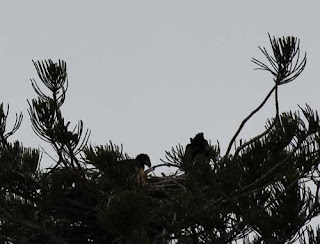Saturday, February 5
After a leisurely morning of grab-your-own breakfast (in my
case, yogurt and a granola bar) and lingering over second cups of coffee/tea,
we set out for Sanibel Island. Our journey began as it always does in Florida,
sitting in a huge traffic jam to get off the island.
We started at Ding Darling National Wildlife Refuge. The
Refuge is a salt marsh on the north side of Sanibel Island. Like most tourists,
we drove through the park, stopping occasionally to take pictures or short
hikes off the road where there are spots of dry land.
We saw an adult ibis with a juvenile. Ibis are so common that they are locally known as “Florida chickens.” We often saw them in yards and parking lots.
 |
| Adult ibis (white), juvenile (mottled) |
There were many, many pelicans. Here is a picture of a brown pelican and a white pelican together.
 |
| White and brown pelicans |
We saw a tricolored heron,
 |
| Tricolored heron |
A yellow-crowned night-heron,
 |
| Yellow-crowned night-heron (during the day) |
And another heron that might have been a juvenile little blue heron. It looked like a little blue except for that pesky white patch. The juveniles start out all white, so my guess is that it just hadn’t finished its molt to adult plumage. I’m sure it must have been embarrassing if all the other kids had lost all their white feathers.
 |
| Juvenile little blue heron? |
On one of the short hikes, a docent was pointing out mangrove tree crabs. “Once you know what to look for,” he said, “you will see them everywhere.” He was right. Although the tree in this picture did not have dark spots at the bases of its branches, most of the trees did. The crabs were nearly impossible to spot until you had your nose right on them.
 |
| Mango tree crabs |
Way, way out on a sandbar, we could just make out two roseate spoonbills. There was a third one at some distance from them. Spoonbills are so cool!
 |
| Two roseate spoonbills |
We didn’t see any alligators at Ding Darling this year. Jane
and Jan said that the birding had been better.
We got a sandwich at a deli and went to Pond Apple retention
ponds. I always wanted to call this “Apple Pond” because it seemed to make more
sense, but I learned on this trip that Pond Apple is a fruit-bearing, salt
tolerant, wetland tree. Got it!
We found a bench where we could sit to eat our sandwiches. The undergrowth was alive with anoles, some of them so tiny they were barely visible. Anoles come in green and brown. This is a brown one.
 |
| Brown anole |
Pond Apple was absolutely lousy with wood storks that had no fear of humans. This one was walking on the path two steps away from me.
 |
| Fearless wood stork |
Ibis were, as usual, everywhere.
 |
| The ubiquitous ibis |
We saw a small green iguana in a shrub,
 |
| Green iguana with a long, long tail |
And a southern black racer by the path—note how long its body is!
 |
| Southern black racer of considerable length |
A great egret groomed itself, showing off the plumes that almost drove it to extinction when feathered hats were popular.
 |
| A great egret showing off its plumes |
Double crested cormorants dried their wings.
 |
| Double crested cormorants |
Anhingas posed for us.
 |
| Anhinga |
This picture shows interesting foraging behavior in wood storks. The stork spread its wing out to shade the water, which makes it easier to see into the water. It then stuck its foot to the side and stamped the bottom, stirring up the mud. The picture shows the bubbles that were produced. Next, it repeated the process with the right wing and foot before moving down the shore.
 |
| Wood stork shades the water and stirs up the bottom |
There was a huge morning glory that had completely taken over a shrub. It wasn't doing the shrub any favors, but the flowers were beautiful.
 |
| Morning glory |
Pond Apple consists of four ponds, but visitors are only allowed on the periphery. The cross pieces, therefore, are safe places for birds and lizards to hang out. The alpha male green iguana, in his orange breeding colors, had staked a claim on one of the banks. I tried to get his bright orange dewlap while it was inflated, but only partially succeeded. He did some vigorous head bobbing as well, probably for the benefit of two females nearby.
 |
| Alpha male iguana with orange dewlap |
And then we sat in a traffic jam to get off Sanibel Island and another to get onto Fort Myers Beach. That’s the trouble with these islands. One bridge, one road. On the way back to the condo, we took a side trip to see the eagle nest. The adults were gone, but we could see two chicks. They looked almost as big as adults. I hoped they would both put their heads up at once, but they did not feel that cooperative. This is the best I could do. The next day, they were gone, and I didn’t see them after that. We caught them the day before they fledged.
 |
| Two eaglets about to fledge. The head belongs to the one on the left. The lump at the right is the other one. |
No comments:
Post a Comment